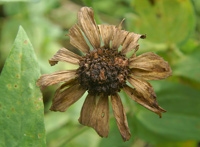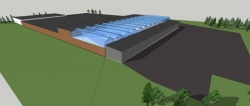The Urban Farmer, Issue #035 * April,
2011: Corporate Gardens * Aquaponics * What
NOT to Grow

“I have no plants in my house. They won’t
live for me. Some of them don’t even wait to die, they commit suicide.”
~Jerry Seinfeld
ROOFTOP GARDENING WITH SKY VEGETABLES

Using heat from a forge that turns out car
parts and hand tools, a Michigan manufacturer is developing an energy-efficient
way to warm a year-round greenhouse on the company’s roof.
David Moxlow, president of Trenton Forging,
started growing fruit and vegetables atop his plant southwest of Detroit in
November; he has already harvested greens, peppers, broccoli, strawberries
and tomatoes, which are shared with employees and visitors. The company is
among a number nationwide that are developing technology and techniques for
rooftop gardening as interest in local and homegrown food grows.
Sky Vegetables
aims to build hydroponic farms on roofs in New York and Washington and in
the Boston and San Francisco areas to make more fresh produce available in
cities. Another company based near Chicago, GreenGrid Roofs, sells a modular
system of plastic bins that make it easier to install rooftop beds.
Rooftop gardens provide environmental
benefits similar to traditional green roofs, in which plants are used to
reduce storm-water runoff, filter pollutants and cut heating and cooling
costs. The gardens also can make it easier for city residents to get fresh
fruit and vegetables, which is seen as a way of improving public health.
WHAT IS AQUAPONICS?

Aquaponics is an integrated aquaculture (growing fish) and hydroponic (growing
soilless plants) system. First, the waste from fish tanks is pumped to a section
of the system to be treated with a natural bacteria that converts the
waste–which is largely ammonia–first to nitrite and then to nitrate. At that
point, the fish waste is in a state that can be used to feed the plants. The
fish wastewater is then pumped to a media bed or other hydroponic system to be
used as nutrient solution by the growing plants.
Aquaponic systems are gaining popularity and
can be used to grow food for personal use or for commercial production. The most
popular fish grown in aquaponic systems is tilapia. However, some growers have
had success growing largemouth bass, perch, carp, crappies, bream, and some
ornamental fish such as koi and goldfish. The plants that are traditionally
grown in these systems are lettuce, other salad greens, and succulent herbs such
as basil. Some commercial systems that feature densely stocked fish tanks can
grow tomatoes, cucumbers, peppers, and even melons.
Most aquaponic systems are located in a
greenhouse. However, some systems can be located outside in temperate or
tropical locations. Some growers even locate small aquaponic systems indoors
next to a sunny window or under artificial lighting. Several companies exist
that sell prefabricated aquaponic systems. However, many creative, enterprising
growers are building their own systems.
To learn more about aquaponics, The Growing
Edge magazine and Web Site regularly feature articles and information on
aquaponic growing. Aquaponics is a growing field and has really caught on over
the last several years. If you’re interested in growing both fish and
plants–either for personal use or for a career–you might find that it’s an
ideal method.
Sounds intriguing and would
be a fantastic setup, right? A word of warning: aquaponics can be very tricky
indeed. Start small and do lots of homework first!
Hydro Tip of the Month
What plants are NOT well suited to hydro? Corn,
zucchini, summer squash, melons. Sure they can be grown in a hydroponic garden,
but they are space hogs, and just not practical. They will take over your whole
unit. Your resources are better spent on crops more suited to the compact
systems. Think small for now— bush or patio strains of beans, tomatoes and
cucumbers.
We hope you have enjoyed this issue of The Urban Farmer Ezine. Each month, we will bring you another inspiring photo, gardening quote or idea, plus fresh new hydroponics news, techniques & products.
Insiders tips to get you growing…

~Stella and Simon from
Hydroponics-Simplified.
|


Reply